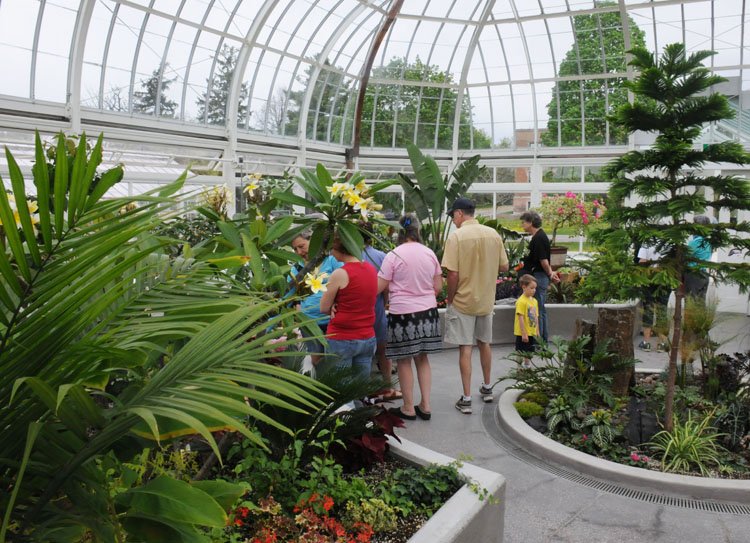There are five public areas to visit at the Central Experimental Farm. For a stylized map, click here. The Arboretum and Ornamental Gardens are cared for by the Friends of the Farm volunteers under the expert direction of Agriculture and Agri-Food Canada staff.
Dominion Arboretum – Free, open dawn to dusk
This magnificent collection of trees and shrubs covers about 35 hectares (86 acres) of rolling land. More than 2,000 varieties have been adapted to the region, some dating back to the first plantings in 1889.
The northeast corner of the Arboretum has its own microclimate. Here, you will see magnolias, rhododendrons, a wisteria and others.
The lookout on the south-east side offers a panoramic view of the historic Rideau Canal and Carleton University, while the north-east overlooks Dow’s Lake and the surrounding city.
Ornamental Gardens – Free, open dawn to dusk
The Ornamental Gardens display historic and new varieties of flowers and shrubs for the interest of amateur gardeners and the general public.
The Gardens include a Heritage Rose garden, Explorer Rose garden, Preston Lilac collection, Peony and Iris collections, Macoun sunken garden, rock garden, perennial and annual beds and hedge collections.
They cover an area of approximately 3.2 hectares (8 acres) and have been a favourite site for wedding photographers since they opened in the 1880s.
Now available – a self-guided walking tour with descriptions and map. In English, en français.
 Merivale Shelterbelt – Free, open dawn to dusk
Merivale Shelterbelt – Free, open dawn to dusk
Thousands of trees once marked the northern and western boundaries of the Central Experimental Farm. The Friends of the Farm worked on a project to recreate a boundary forest at the western edge of this National Historic Site – the Merivale Shelterbelt. It is now beautifying the surroundings and provides a recreational path. It will protect the fields from salt and soil erosion and will help clean the atmosphere. The Shelterbelt runs the length of Merivale Road heading north from Baseline Road (see diagram and sketch from original plan) and features trees such as Colorado spruce, green ash, maple and walnut, along with shrubs such as lilac, honeysuckle and serviceberry.
A recreational path weaves through the beds of trees and shrubs and offers a beautiful start or finish to a walking tour of the Farm. The Shelterbelt will beautify the surroundings and mark the edge of the heritage landscape of the Farm for years to come. A plaque wall in a supporters’ pavilion and rest area acknowledges the special contributions made by donors.
Now available – a self-guided walking tour with descriptions and map. In English, en français.
Tropical Greenhouse – Free, open Mon-Fri and Sun
The Tropical Greenhouse is owned and operated by Agriculture and Agri-Food Canada and is located on Maple Drive across from the Saunders Building. It has been recently renewed and replanted with a larger, more diverse collection of exotic tropical plants.
The elegant octagonal structure was originally built at Major’s Hill Park in downtown Ottawa and moved to the Farm in 1938 to be used for horticultural research. Now a heritage building, it became a tropical garden open to the public in the 1970s.
Normally open Monday to Friday, 9 a.m. to 4 p.m.; Sunday 10 a.m. to 4 p.m.; closed Saturday for maintenance.
 Canada Agriculture and Food Museum
Canada Agriculture and Food Museum
Canada’s unique agricultural heritage is featured at the Canada Agriculture and Food Museum, part of the Canada Science and Technology Museums Group, Ingenium.
For a modest entrance fee, you can explore the sights and sounds of traditional farm life. For information about barn animals or museum events, please visit the museum website or phone 613-991-3044.
Fletcher Wildlife Garden – Free, open dawn to dusk
The Fletcher Wildlife Garden (FWG), a long-term project of the Ottawa Field-Naturalists’ Club, is located on a site that is only minutes from the centre of Ottawa.
Besides being readily accessible to naturalists, gardeners, schoolchildren, and other residents of the city and its suburbs, the FWG site encompasses a variety of natural habitats, including a backyard garden, butterfly meadow, amphibian pond, new and old woodlots, plus many walking paths throughout.
Volunteers are working to restore and enhance these and other areas to provide a wide range of potential homes for local wildlife.




